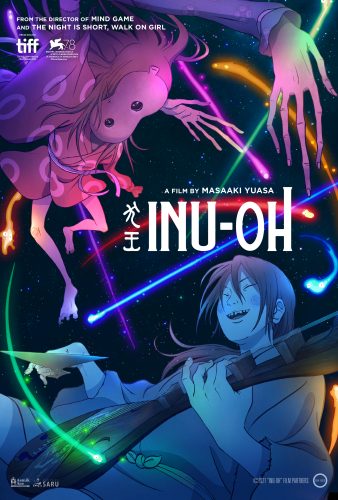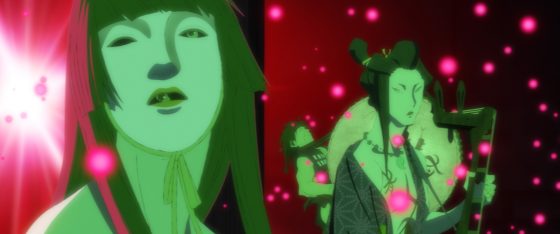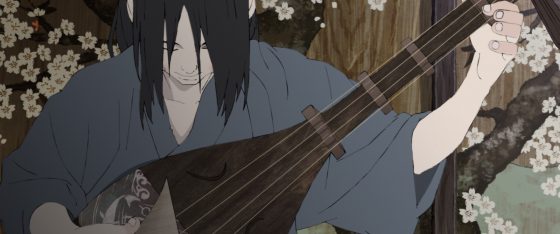Inu-Oh [Movie] Review – Rocking Out in Feudal Japan


Legendary anime director Masaaki Yuasa is back with a new film, and this time it’s all about the transformative power of music! You may recognize Yuasa from his other works like Devilman Crybaby, Keep Your Hands Off Eizouken, or Ride Your Wave; but whether this is your first time or your tenth experiencing his signature unhinged style, the delightful insanity of Inu-Oh is sure to capture your attention. Still, is this tale of feudal Japanese musicians forging their identities through medieval metal concerts actually worth your time? Let’s find out in our review of Inu-Oh! Inu-Oh, distributed by GKIDS, releases on August 12, 2022 in select US theaters.
Inu-Oh Official Trailer | Nippon Connection Filmfestival 2022
[ad_top2 class="mt40"]Synopsis

In the 14th century Muromachi era, a young boy named Tomona and his father make a living diving for artifacts from a long-ago war. This war and the samurai who fought in it are chronicled in an epic account called “The Tale of the Heike”. One day, Tomona is tasked to dig up a sacred regalia sword, which is filled with so much spiritual power that it accidentally blinds him and kills his father. Tomona then joins a group of biwa monks – string instrument playing priests who narrate “The Tale of the Heike” to calm the restless spirits of these samurai so they don’t cause misfortune. There’s a rigidly established canon of stories, but he believes that if he can unearth tales that have been forgotten by the world, he can bring peace to both himself and these lingering spirits. Along his journey, he befriends an odd dancer named Inu-Oh. In real life, Inu-Oh was a popular Noh theater performer in the Muromachi era. However, very few documents about his life survive, so pretty much everything about him – including why he was such a sensation in his time – is a mystery. This film, combining aspects of the 2017 novel “The Tale of the Heike: The Inu-Oh Chapters” by Hideo Furukawa with Masaaki Yuasa’s own ideas, creates a narrative where Inu-Oh has been cursed by demons since birth to look like a hideous monster. He dreams of dancing up on stage, and one day when he truly dances his heart out, small floating spirits appear and break the curse on his legs. Tomona and Inu-Oh figure out that these were the forgotten Heike warriors, and they decide to form their own troupe to bring these stories to the masses. However, those in power don’t appreciate this new underground movement undermining their traditions...
Wonderfully Weird

To go along with this somewhat bizarre plot, the animation and music of Inu-Oh are equally strange. Masaaki Yuasa’s animation style is rough, abstract, and even purposefully ugly sometimes, but it works because it captures raw emotion so well. You can see Tomona’s crooked teeth and his emaciated body as he sings from the depths of his soul, and Inu-Oh’s exaggerated proportions and patchwork patterned clothing paint him as an alien-like being who gradually becomes more human as his curse breaks little by little. We also love the point-of-view shots that show how each character sees the world – Inu-Oh peers through the tiny lopsided holes of his mask, while Tomona’s “sight” is depicted as colorful brushstrokes that vaguely outline things like human silhouettes or rain falling on a temple. It may take a while to get used to it, but we think the visual style works perfectly for this film. The lengthy musical sequences are also quite different from anything we’ve ever seen before. They’re deliberately anachronistic, bringing in ‘80s dance moves and rockstar antics to transform traditional Japanese musical theater into raucous concerts complete with screaming fans and special effects. Intriguingly, the effects are shown to be created by inventions that could’ve been made at the time, like wire rigs suspended on ziplines and light projections made by passing stencils over paper lanterns. The music itself uses a mixture of period-accurate instruments and modern ones to form a unique sound that bucks tradition while still being steeped in it. Many of the voice actors are also veterans of the musical stage, so their performances have the kind of presence that belongs in front of a crowd.
The Struggle of Living Your Truth

Throughout their adventures together, Tomona and Inu-Oh change dramatically – so much so that we’re amazed we can tell we’re looking at the same characters after so many design changes. Inu-Oh regains his human body piece by piece, discarding his many layers of clothing to show off his toned figure, while Tomona goes for a more androgynous rockstar style. He lets his hair down, begins wearing makeup and feminine kimonos, and seems much more comfortable in his own skin. He also changes his name twice throughout the film: first from Tomona to Tomoichi as a requirement to join the biwa priests, and then from Tomoichi to Tomoari when he and Inu-Oh decide to take their act around the country. The last name change is particularly significant, since it’s something he chose himself and represents his and Inu-Oh’s will to tell the stories of the lost and forgotten – not because of any curse or tragedy, but because everyone deserves to be heard. Unfortunately, this is when the powers that be (including the shogun) begin cracking down on their art and demanding that they stick to the established canon or suffer dire consequences. Anyone who’s ever had to defend their own identity to an uncaring public can relate to this struggle, especially those in the LGBTQ community. And since several of Yuasa’s works have featured queer characters, we’d say that this angle was intentional. We definitely cried at parts of this movie, and we bet you will, too.
Definitely Not for Everyone

Because every aspect of Inu-Oh is so unabashedly weird, it’s not a film that everyone will like. The narrative is told in a dream-like way with many timeskips and can require some googling for those unfamiliar with Japanese theater and history. The character designs (by Ping Pong mangaka Taiyou Matsumoto) and non-traditional animation are constantly shifting and don’t resemble normal anime. The concert segments can get repetitive because of how drawn-out they are, and certain scenes deal with levels of violence and tragedy that can be too much for some people. But if you go in with an open mind, you might just find one of your new favorite anime movies. That’s what happened for us!
Final Thoughts

If you’re a music lover and/or you enjoy bizarre anime, we urge you to give Inu-Oh a try. And if you can catch it in theaters, the huge screen and surround sound system will make the experience that much better. Let us know if you’re excited to see Inu-Oh, and thanks so much for reading!
[recommendedPost post_id='352019' url='' title='' img='' class='' widget_title=''] [recommendedPost post_id='234228' url='' title='' img='' class='' widget_title=''] [recommendedPost post_id='352762' url='' title='' img='' class='' widget_title='']

No comments